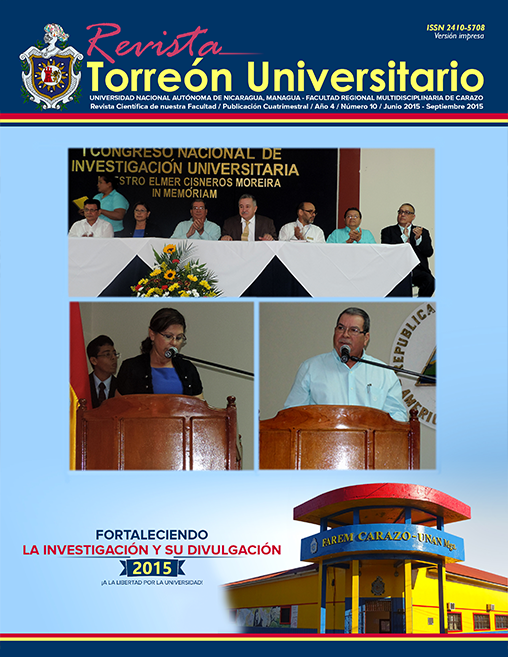History and Identity: Education in the Careers of the Teaching Department of Sciences of Education and Humanities of FAREM-CARAZO
Abstract
This article frames up on the thematic axis of university investigation. It was carried out in the department of Education and Humanities of the Regional Multidisciplinary Faculty of Carazo of the UNAN-Managua, during the second semester of 2014. The goal of the investigation is to explain the sense of national identity that is wanted to be taught in the History of Nicaragua subject. In order to achieve such objective, the didactic triangle was analyzed comparatively: curriculum, teachers and students. Main conclusions were detected that each component assumes stereotypes according to identities, though the subject syllabus follows the regional historiographical trend.Downloads
References
ARROLLO CHINCHILLA, L., HUERTAS CASTRO, P., PEIRANO CISTERNA, C., Y PÉREZ CALVO, M. (2014). La identidad del adolescente y su relacion con el imaginario nacional costarricense. Actualidades Investigativas en Educación, 14(2), 1-32. Recuperado el 06 de octubre de 2014, de revistas: www.ucr.ac.cr/index.php/aie/article/view/14798
CANELA, A. L., Y MORENO RAMOS, M. T. (2009). La identidad nacional: planteamiento y evolución de un modelo estructural. Obets(9), 19-30. Recuperado el 15 de diciembre de 2014, de publicaciones: www.ua.es/filespubli/pdf/19891385RD32601266
CERUTTI, A., Y GONZÁLEZ, C. (2008). Identidad e identidad nacional. Revista de la Facultad(14), 77-94. Recuperado el 20 de octubre de 2014, de fadeweb: www.uncoma.edu.ar/extension/publifadecs/.../08-Cerutti&Gonzalez
FUNES, A. G. (2010). Enseñanza de la Historia y las finalidades identitarias. Enseñanza de las Ciencias Sociales(9), 87-96. Recuperado el 20 de octubre de 2014, de: www.redalyc.org/pdf/3241/324127609009.pdf
GARCÍA BRESÓ, J. (2014). Mecanismos culturales para mantener la identidad entre los indios monimboseños de Nicaragua. Encuentro, 30 - 43. Recuperado el 14 de octubre de 2014, de: http://www.lamjol.info/index.php/ENCUENTRO/article/view/1444
GÓMEZ CARRASCO, C. J., Y MILLAREZ MARTÍNEZ, P. (2013). La enseñanza de la historia desde un enfoque social. Clío(39), 1-16. Recuperado el 15 de octubre de 2014, de: www.ub.edu/histodidactica/images/.../La_enseanza_historiasocial.pdf
GOULD, J. L.(1997) El mito de la Nicaragua mestiza. San José: Universidad de Costa Rica.
KINLOCH TIJERINO, F. (1999). Nicaragua: identidad y cultura política (1821-1858). Managua: Banco Central de Nicaragua.
MILLARES MARTÍNEZ, P., PRATS CUEVAS, J., Y TATJER MIR, M. (2014). Conocimientos y concepciones de estudiantes españoles y latinoamericanos de educación secundaria obligatoria sobre las independencia políticas americanas. Revista electrónica de Geografía y Ciencias Sociales, 1 - 17. Recuperado el 13 de octubre de 2014, de: http://www.ub.edu/geocrit/sn/sn-418/sn-418-34.htm
NORABUENA URRUTIA, P., Y MANCILLA LE-QUESNE, V. (2005). La identidad cultural como fuente de aprendizaje significativo. Geoenseñanza, 10(2), 219-134. Recuperado el 17 de diciembre de 2014, de: www.saber.ula.ve/bitstream/123456789/21014/2/articulo7.pdf
PAGÉS, J. (2002). Aprender a enseñar Historia y Ciencias Sociales: el curriculum y la didáctica de las Ciencias Sociales. Pensamiento educativo(30), 255-269. Recuperado el 15 de diciembre de 2014, de: www.pensamientoeducativo.uc.cl/files/journals/2/.../222-523-1-PB.pdf
ROMERO, J., CHOW CRUZ, A., FRANCO, F., MADRIGAL MENDIETA, L., HERNÁNDEZ SÁNCHEZ, N., NORORI GUTIÉRREZ, R., . . . REYES MONTERREY, J. (2010). Historia de Nicaragua. Managua: Ciencias Sociales.
SAIZ SERRANO, J., Y LÓPEZ FACAL, R. (2012). Aprender y argumentar España. La visión de la identidad española entre el aumnado al finalizar el bachillerato. Didácticas de las Ciencias experimentales y sociales(26), 95-120. Recuperado el 17 de diciembre de 2014, de: www.ub.edu/.../Siz%20%20Lpez%20Facal%202012%20Aprender%20y...
SALAZAR, J., Y SALAZAR, M. (1998). Estudios recientes acerca de identidades nacionales en América Latina. Psicología Política, 75 - 93.
Downloads
Published
How to Cite
Issue
Section
License
Copyright (c) 2016 Revista Torreón Universitario

This work is licensed under a Creative Commons Attribution-NonCommercial-NoDerivatives 4.0 International License.
The authors who publish in this journal agree to the following terms.
- The author or authors of the articles, essays or research grant the National Autonomous University of Nicaragua, Managua (UNAN-Managua) the editing rights (copyright) of the submitted work, therefore the University has the exclusive right to publish the article for the entire copyright period.
- These copyrights/authors authorize Torreón Universitario Magazine and the University to edit and disseminate/publish the article in said Magazine, including printed and electronic reproduction, storage, retrieval and any other type of publication, and sources of secondary information as services. of summaries and databases, they also empower it to protect the article against unauthorized use for dissemination by printed or electronic media (PDF, HTML, EPUB, XML or others).
License for use of content
The magazine uses the Creative Commons Attribution-NonCommercial-NoDerivs 4.0 International License.
Under this statement:

This journal is licensed under a Creative Commons Attribution-NonCommercial-NoDerivatives 4.0 International License. It can be copied, distributed and transmitted publicly as long as the author and source are cited (Revista Torreón Universitario), it should not be modified or used for any commercial purpose. The full license can be found at http://creativecommons.org/licenses/by-nc-nd/4.0/.



